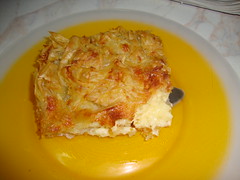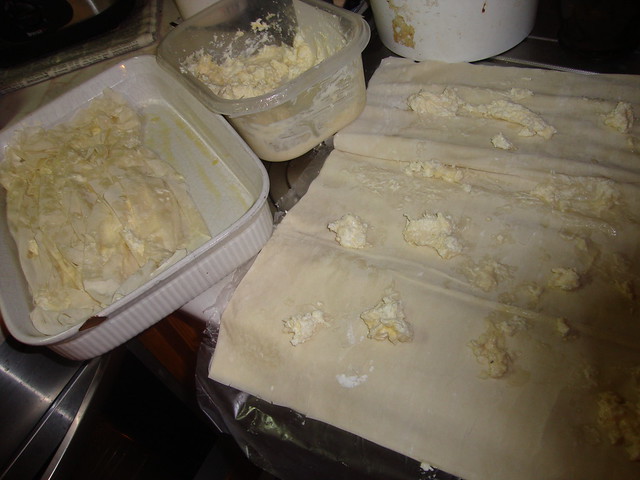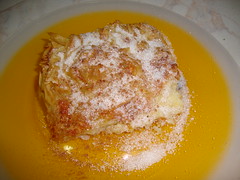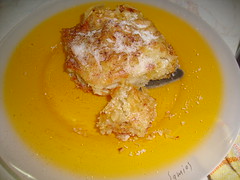First post for the year, and it's almost back to work for me; I hope it's been a good start so far for all of us.
I was attracted to the sound of the raggedy-sounding name of a pie on Kalofagas' blog, called patsavouropita, which basically translates to 'rag pie' (πατσαούρι - 'patsavouri' is a piece of raggedy cloth, often used for cleaning). For a pie to get this kind of name, it probably means that it can be made quickly and slap-dash. Perfect: that's the way I like to cook these days, to simplify my kitchen work as much as possible due to work pressures.
The way that the filo pastry is worked in this cheesy pie makes it a raggedy mess. No matter how you layer it, whether it breaks up or how it's placed, it will make no difference to the final taste, appearance and texture of the cooked pie. Almost any mixture of soft white and grated yellow cheeses can be used, according to your eaters' preferences. What's more, this savoury pie can be turned instantly into a sweet, at the same serving. Not only that, but it freezes well before the cooking stage, and doesnt need defrosting when you are ready to cook it. What more could you ask for in a pie?
I've made some slight adaptations to the original recipe: I don't like too many eggs in cakes or pies, I always try to replace butter with olive oil, and I am also a make-and-do cook, so I'll use what's at hand, rather than go out and buy special ingredients.
You need:
1 packet of defrosted filo pastry
4 cups of a mixture of crumbled feta cheese and mizithra (I used teleme, a cheap very mild white cheese with the consistency of feta, and Cretan mizithra - cheap ricotta, or a strained cottage cheese can also be used; the first time I made this, I also used a small amount of grated yellow cheese)
2 eggs
1/2 cup milk
salt (optional: feta cheese is usually salty; I generally cook everything with very little salt)
olive oil for greasing and drizzling over
1 330ml can of soda water
Grease your baking tin(s) well. I always make two small pies - one for eating straight away, and one for freezing. (I have even made this pie in individual ramekins, which is particularly apt, as this kind of pie is best served warm.) Open the packet of filo pastry to air the sheets so that they will be slightly dry rather than slightly moist (it will help the pastry to become crispy). Mix the eggs, cheeses and milk until everything is well-blended. Add salt to taste. Pour teaspoons of this mixture haphazardly over the first filo pastry sheet. Gather the pastry sheet like an accordion and place this strip onto the baking tin. Repeat the last two steps until enough pastry sheets have been placed side-by-side to fit tightly into the baking tin. Drizzle some olive oil over the pie and brush it all over the pastry. Then pour over the soda water; if making more than one pie, divide the can evenly among the tins. If you are going to freeze the pie, don't pour any soda over it - you will do that when you cook it.
Cook the pie in a moderate oven (180C) for 30-40 minutes, until the pie takes on a golden brown colour on the top. The frozen pie is cooked without defrosting: place the tin as is in the pre-heated oven for 10 minutes, then pour the appropriate amount of soda water over the pie and let it cook long enough until the pastry on the top is golden brown. It won't take much longer than 30 minutes.
Cut the pie into serving pieces and serve it as soon as it cools down slightly. This pie tastes best when still warm; leftover pie can be reheated in the microwave. It is good with a green salad, served as a light lunch.
This pie creates its own dessert. Serve it still warm with a sprinkling of sugar over it (crystalline white sugar is good, while brown muscovado sugar gives it a caramelised finish) and a dash of cinnamon powder, and it becomes a bougatsa. We eat this pie as a sweet more often than a savoury.
I now make this pie regularly, and always in large quantities, so that I can freeze at least one pie for later use. I can say that the frozen pie comes out better than the fresh pie which was cooked when it was made; something to do with the chemistry, I suppose.
©All Rights Reserved/Organically cooked. No part of this blog may be reproduced and/or copied by any means without prior consent from Maria Verivaki.





You just reminded me how much I want to make Peter's recipe! I must try the bougatsa version - what cheese did you use for those?
ReplyDeleteThis looks really good. I think it would be worth making extra to have in the freezer.
ReplyDeleteGreat post (once again, not surprisingly), Maria! You are starting out the new year in fine form. :-) I continue to really enjoy reading your posts. Learning lots and then applying in my kitchen. I am cooking as a novice in Greece but love the opportunities and challenges that are presented; you are really helping me find my way in my "Greek kitchen." Seems we have very similar tastes and interests. I am truly grateful to you! Sending best wishes for the new year...
ReplyDeleteGlad you enjoyed the Patsavouropita...funny name for a dish and easy and delish! Did the kids help you make the pie? It seems like one of those fun recipes the children can help with.
ReplyDeleteΚαλή χρονιά με υγεία και ευτυχία:)
ReplyDeleteI don't like many eggs in pies as well. Usually, I don't add any eggs at all! This is an easy and tasty pie!
ReplyDeleteI love both versions Maria! It's a great recipe...the name of it always makes me laugh. All the best to you and your family for 2011!
ReplyDeleteI remember this pie made an impression on me when Peter first posted about it for the soda water that gets poured over it. I've got to try it now as well ... I am sure it will become a family favorite in this household as well.
ReplyDelete